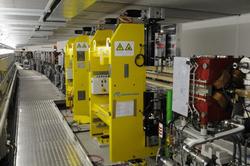PETRA III accelerator with undulators
DESY’s new synchrotron radiation source PETRA III stored its first beam ion 16 April, 2009. At 10:14 am, the positron bunches were injected and stored in the 2.3-kilometre accelerator for the first time. During future user operation, up to 960 particle bunches containing up to 10 billions of positrons – antiparticles to electrons – will circle the storage ring around the clock at almost the speed of light, emitting a unique light for science. The start of operation concludes the two-year upgrade which converted the storage ring PETRA into a top-class X-ray radiation source.
“With PETRA III, DESY is commissioning another X-ray light source for research, a facility without comparison worldwide,” said Professor Helmut Dosch, Chair of the DESY Board of Directors. “With this lightsource we will offer the most brilliant synchrotron radiation to our users, setting new standards in photon science.” As the most powerful lightsource of its kind, PETRA III will offer excellent research possibilities, in particular to those researchers who investigate very small samples or those who require tightly focused and very short-wavelength X-rays for their experiments.
The 225-million-Euro remodelling was largely funded by the Federal Ministry of Education and Research (BMBF), the City of Hamburg and the Helmholtz Association. A 300-metre-long experimental hall was built over one eight of the PETRA ring, housing 14 synchrotron beamlines and up to 30 experimental stations. To ensure that the high-precision measuring equipment in the experiments is not affected by vibration, the experiments will be installed on the largest monolithic concrete slab in the world.
After the stable storage of the particle beam achieved today, the accelerator will be set up for the production of the most wanted synchrotron radiation in the coming weeks. The undulators – special magnets producing synchrotron radiation – will be positioned close to the particle beam, making the positrons follow a zigzag course to make them emit synchrotron radiation. At the same time, the mounting of the 14 beamlines, to be used by user scientists for their experiments, continues in the experiment hall. A first test run with synchrotron radiation is planned this summer; regular user operation of the third generation synchrotron radiation source will start in 2010.
(from: DESY press release)






